A new book just hit the shelves, last week. Buddy's Bedtime Battery by Chirstina Geist (published by Random House) is my latest book and I want to take you behind the pages to see how the project progressed.
Viewing: Blog Posts Tagged with: Bedtime, Most Recent at Top [Help]
Results 1 - 25 of 78
Blog: Tim Bowers Art Blog (Login to Add to MyJacketFlap)
JacketFlap tags: illustration, robots, book illustration, pajamas, oil painting, bedtime, children's book, moon, kids books, stars, painting process, rocketship, art studio, tim bowers, beep, christina geist, buddy's bedtime battery, Add a tag
Blog: The Children's Book Review (Login to Add to MyJacketFlap)
JacketFlap tags: Bedtime, Sleep, Bedtime Stories, Author Showcase, Elizabeth Alger, Sleeping Books, Add a tag
This charming fairytale, The Kitten Who Wants to Fall Asleep, is interwoven with psychological sleep-inducing techniques which are astonishingly effective.
Add a CommentBlog: drawboy's cigar box (Login to Add to MyJacketFlap)
JacketFlap tags: bedtime, sleep, mother, childhood, hug, bones, friend, fireflies, gargoyle, Patrick Girouard, dig, Drawboy, girl, boy, monster, illustration friday, Add a tag
Blog: Kid Lit Reviews (Login to Add to MyJacketFlap)
JacketFlap tags: Children's Books, Picture Books, bedtime, witches, conflict resolution, sleeplessness, Creston Books, Debut Illustrator, Robin Newman, 5-Stars, Chris Ewald, Hildie Bitterpickles Needs Her Sleep, Add a tag
A quick note, if you’ll indulge me. I have been gone for a few days, thanks to the lupus. The fatigue alone was, well, tiring. The disease in unpredictable in many ways, especially when it will cause trouble. Nothing to fret about, but I didn’t want you to think I’d abandoned ship. I am excited …![]()
Blog: The Children's Book Review (Login to Add to MyJacketFlap)
JacketFlap tags: Ages 0-3, Photography, Bedtime, Board Books, Baby Books, Bedtime Books, Elizabeth Verdick, Marjorie Lisovskis, Add a tag
REST and PLAY, by Elizabeth Verdick and Marjorie Lisovskis are two delightful books for newborns through two years old.
Add a CommentBlog: Darcy Pattison's Revision Notes (Login to Add to MyJacketFlap)
JacketFlap tags: bedtime, sleep, bedtime story, rabbit who could not sleep, Picture Books, Add a tag
Swedish psychologist Carl-Johan Forssén Ehrlin surprised the book publishing world this summer as his book for children and their parents shot to number one on Amazon. The Rabbit Who Wants to Fall Asleep is a self-help book that gives parents a script to follow as they try to get a child to go to sleep. Because of its performance on Amazon, Penguin has picked up the book for a reported seven-figure deal.
Of course, I had to read it. Buzz does sell books.

Rabbit (if I can casually call it by the name of the insomniac main character) reminds me of the Academy Awards ceremony. Screenwriters, directors, actors and actresses, cinematographers and the full complement of support staff for a major move were awarded the highest honor that filmmaking can bestow, Academy Awards. And for every movie about a cause—from elderly rights to gay rights and beyond—the person being honored felt compelled to stand up and explain why their cause was so important and timely. . . thereby negating the art for which they’d just been honored.
Why did they not trust their art to plead their cause in deeper and stronger ways than a week diatribe made during a gala ceremony? It baffles me.
In the same way Ehrlin explains why a good bedtime story works. He has built into the script certain keywords – sleep now, yawn, now—which should help put the child in the right frame of mind. Further, he uses some words because they sound calm and slow, thus reinforcing the desired frame of mind. Repetition finds its place as a tool to calm and convince a child to fall asleep.
But why does Ehrlin feel the need to explain it all so blatantly? Perhaps, it’s because parents don’t go behind the scenes for a children’s bedtime story; they don’t understand, and therefore don’t trust, that the writer really knows what s/he is doing when writing this kind of story.
In fall 2016, I’ll join the ranks of authors with a bedtime story, ROWDY: The Pirate Who Could Not Sleep. Let me show you what’s behind the curtain of my writing process.

The Sounds of Words
As a young writer, I once heard Newbery medalist Lois Lowry speak about a story that ended in a quiet moment that she hoped would calm a child and help them sleep. She avoided harsh-sounding words and used soft words. That’s right. The way the words sounded was just as important, if not more so, than the meaning of the words.
Poets John Ciardi and Miller Williams said a similar thing in their classic book, How Does a Poem Mean. They emphasize the “connotations speaking to connotations,” an effect they say will create imagery and symbolism. In other words, it matters whether you use the word “fire” or “inferno” because of how it sounds, its connotations and its definitions. Just as important, though, is how it affects the rhythm pattern of your piece of writing. Fire has only one syllable, while Inferno has three syllables; using one over the other affects the rhythm patterns of the writing.
I have a B.A. in Speech Pathology and an M.A. in Audiology; one of the most useful classes from my college years was phonics, or the study of how sounds are made in the human mouth and how to record those sounds with the International Phonetic Alphabet.
For a bedtime story, you want to avoid harsh sounding consonants, what phonetics calls fricatives or affricatives: f, v, th, t, d, sh, zh, ch, j, s and z. Other sounds to avoid are the plosives: b, p, t, d, k, g. You can’t avoid these two major groups of consonants entirely! But you can minimize them, especially when you want the words to be the softest.
Another distinction phonetics makes is among voiced or unvoiced consonants. Put your hand on your throat and say T –T –T ; repeat with D – D – D. Do you feel that your vocal cords vibrate for the D, but not for the T? T is unvoiced; D is voiced. Unvoiced consonants are softer, and more suited to bedtime stories.
The softest sounds are the glides: w, l, r and y. These are the real winners for a calming bedtime story.
For vowels, you should understand that some vowels involve lots of tension in the mouth, while some are created with a relaxed mouth. Say a long A; now say AW. Do you feel the difference in the mouth’s tension?
Ehrlin merely takes a clue from phonetics/linguistics and uses relaxed vowels, along with soft consonants.
Why is a rabbit the right animal for Ehrlin to choose for a bedtime story? Rabbit is a relatively calm word: Glide R; short A is relatively relaxed; B is a plosive, but it’s buried in the word’s middle; UH is a relaxed vowel; T is a plosive but because it’s unvoiced, or your vocal cord doesn’t vibrate for it, it’s relatively calm.
My Fall 2016 bedtime story, ROWDY: THE PIRATE WHO COULD NOT SLEEP, is about Captain Whitney Black McKee. She’s a rowdy pirate captain who fights sea monsters and returns to home port, but finds that she can’t sleep. Her crew goes a’thievin’, in search of a lullaby to help her sleep. In the end, the cabin boy brings back her Pappy who sings her a lullaby.
Here’s that last stanza, which you cannot read it harshly because the words, the phrasing and the story that I wrote demand that you say it softly.
Then Pappy sang of slumber sweet,
while stars leaned low and listened.
And as the soft night gathered round.
The pirates’ eyes all glistened.
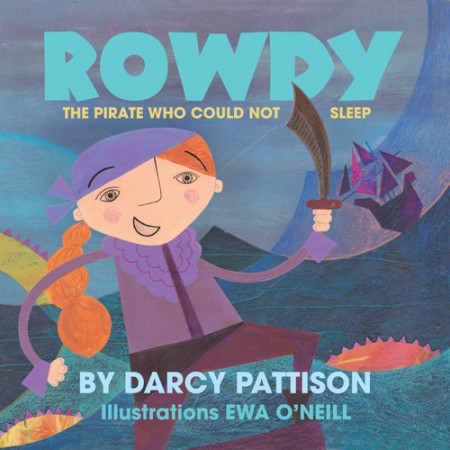
GREAT bedtime stories include. . .
- Child-in-lap relationship. Mem Fox, the beloved Australian writer, talks about the importance of keeping in mind the child-in-the-lap relationship. She means that when you read a story to a child, you are also developing a relationship with that child. She likes to end stories with something that will make the child turn to the adult and give them a hug or say, “I love you.”
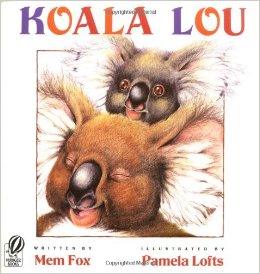 Her beloved book, Kaola Lou, has the refrain, “Kaola Lou, I do love you.” And of course, it’s hard to read without also saying to the child in your lap, “I love you.”
Her beloved book, Kaola Lou, has the refrain, “Kaola Lou, I do love you.” And of course, it’s hard to read without also saying to the child in your lap, “I love you.” - Language development. The great bedtime stories take into account the whole child, not just his or her ability to go to sleep quickly. Instead, they develop a child’s language. Because these are books provided at developmentally appropriate times in a child’s life, it’s an opportunity to entice them with language: the sounds of their native language, the vocabulary, the rhythm patterns and so on. Kindergarten teachers spend time teaching nursery rhymes (Jack be nimble; Jack be quick; Jack jump over the candlestick.) because it develops skills in language.
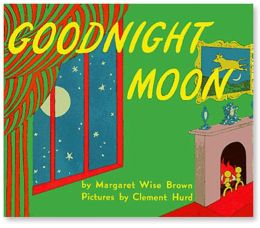
In a like manner, the classic Goodnight Moon! by Margaret Wise Brown uses rhythm, refrains and much more. Consider the humor of this line: “Goodnight, nobody.” It makes for a story that you don’t mind reading for the 1000th time. - Story. As children develop language, an important skill is the ability to understand stories. This involves sequencing of events (beginning, middle, end), understanding cause-effect relationships, character motivations and much more.
 Llama, Llama Red Pajama by Anna Dewdney has an appropriately simple story. Baby Llama is tucked into bed, but when Mama leaves the room, he calls that he needs a drink of water. The plot complication is just that Mama is delayed in bringing up the water, so Baby Llama panics. When Mama shows up, she reassures him that she is “always near, / even if she’s / not right here.” It’s a gentle, reassuring story. And while it tells the story, it also gives kids experience in understanding Story.
Llama, Llama Red Pajama by Anna Dewdney has an appropriately simple story. Baby Llama is tucked into bed, but when Mama leaves the room, he calls that he needs a drink of water. The plot complication is just that Mama is delayed in bringing up the water, so Baby Llama panics. When Mama shows up, she reassures him that she is “always near, / even if she’s / not right here.” It’s a gentle, reassuring story. And while it tells the story, it also gives kids experience in understanding Story. - Vocabulary building. Kids love big words—in the right context.
Jane Yolen’s story, How Do Dinosaurs Say Good Night? provides great fun with the names of various dinosaur species. What kid can resist words such as Allosaurus, Pteradon, Apatosaurus, and Tyrannosaurus Rex? But Yolen also includes words appropriate for the bedtime hour. “Does a dinosaur slam his tail and pout?”
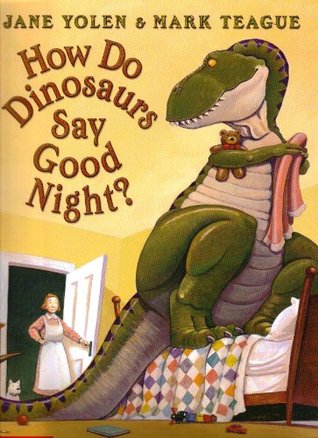
You can’t read this without screwing up your face in a pout, thus teaching the meaning of a vocabulary word in a natural context.
My own bedtime story is titled ROWDY: The Pirate Who Could Not Sleep (to be released Fall, 2016). Will kids know the meaning of “rowdy”? Doubtful. But within the story’s context, they’ll learn it. Bedtime stories, then, are a comfortable and natural context for teaching new words.
Great children’s book authors create works that don’t need the artificial crutches of bold and italic fonts to tell the adult reader how to present the story. Instead, it’s right there in black and white on the page. It tells a great story that reinforces language and vocabulary development. And when it’s done right, a great bedtime story gives an adult an opportunity to give the kid a hug and a kiss and say, “I love you.”
Take the Quiz: ARE YOU READY TO WRITE and SELL A CHILDREN’S PICTURE BOOK?
Blog: Tim Bowers Art Blog (Login to Add to MyJacketFlap)
JacketFlap tags: illustration, book illustration, painting, bedtime, children's book, tim bowers, beep, christina geist, Add a tag
Each book project requires about twenty pieces of art and some of them are very time consuming if there is much detail involved. A book takes several months of work and somewhere in the middle of the process, I start to feel a little overwhelmed. I usually paint in a production line sort of way, mixing a few colors and hitting several paintings with that paint.
By the way, it is still 2015, right?
Blog: Perpetually Adolescent (Login to Add to MyJacketFlap)
JacketFlap tags: bedtime, children's picture books, Mother's Day, New Frontier Publishing, New Book Releases, Anna Walker, Scholastic Press Australia, Dimity Powell, Book Reviews - Childrens and Young Adult, Amanda Francey, Hurry UP Alfie, Alfie's Lost Sharkie, Alice Rex, Onsie Mumsie, onsies, Add a tag
Putting the kids to bed is a rite of passage that not every parent survives in tact. Bedtime can be fraught with misadventure and procrastination. A five-minute goodnight kiss can draw out into a production of Oscar winning proportions. If you have kids under seven-years-old, chances are you’ve experienced a night or two like this. […]
Add a CommentBlog: The Children's Book Review (Login to Add to MyJacketFlap)
JacketFlap tags: Poetry & Rhyme, Candy Books, Katherine James, Ages 4-8, Picture Books, Food and Drink, Tradition, Author Interviews, Bedtime, Gift Books, featured, Author Showcase, Family Traditions, Jan Dolby, Add a tag
On special occasions the girls’ parents told them of THE SUGAR PLUM TREE and they awoke to small candy treats or TREASURE waiting under their beds. It’s this TRADITION, of POETRY IN ACTION, the girls now hope to pass on to your family.
Add a CommentBlog: The Children's Book Review (Login to Add to MyJacketFlap)
JacketFlap tags: Poetry & Rhyme, Candy Books, Katherine James, Ages 4-8, Picture Books, Food and Drink, Tradition, Bedtime, Gift Books, Author Showcase, Family Traditions, Jan Dolby, Add a tag
Inspired by Eugene Field’s (1850-1895) original The Sugar Plum Tree poem, here is a deliciously sweet bedtime book from Katherine James that takes young readers across the Lollipop Sea to the Garden of Shut Eye Town where the Sugar Plum Tree grows.
Add a CommentBlog: The Children's Book Review (Login to Add to MyJacketFlap)
JacketFlap tags: Giveaways, Book Giveaway, Bedtime, Sleep, Andrew McLeish, Add a tag
Enter to win an autographed copy of The Sandman, by Andrew McLeish. Giveaway begins June 10, 2014, at 12:01 A.M. PST and ends July 12, 2014, at 11:59 P.M. PST.
Add a CommentBlog: Kid Lit Reviews (Login to Add to MyJacketFlap)
JacketFlap tags: Paul Czajak, Scarletta Kids, Wendy Grieb, Children's Book Week celebrations, going to bed and stalling, Children's Books, Picture Book, Poetry, Favorites, monsters, Series, bedtime, children's book reviews, 5stars, Scarletta Press, Contests-Giveaways, Library Donated Books, Add a tag

.
.

Book 2: Monster Needs His Sleep
written by Paul Czajak
illustrations by Wendy Grieb
Scarletta Kids 4/15/2014
978-1-938063-26-8
Age 4 to 8 32 pages
.
“In this silly bedtime story, it’s time for bed, and Monster needs to go to sleep. But he just keeps finding more things to stay awake for! It isn’t until Monster admits he is afraid of the dark that he finds a glowing solution to his nightmare problem. In this playful, rhyming story, Monster shows kids that with a little help from a friend, the dark isn’t so scary after all. The Monster & Me™ series helps kids build character, social, and emotional learning skills through entertaining and memorable real life situations”
Opening
“Monster needs to get his sleep. It’s time to go to bed. But when I said it’s sleepy time, he roared, “Let’s play instead!”
Interview with Boy and Monster. If you have not read this, it is worth checking out! Click HERE.

Review
In the first book in the Monster & Me™ series, Monster Needs a Costume, it is Halloween and Monster cannot decide what to wear. He tries on several costumes, all of which are great for Monster, but none of which he wants. In the long awaited follow-up, Monster Needs His Sleep, Monster simply needs to go to sleep. Boy must be exhausted after caring for Monster all day, but he has one more thing to do before tomorrow can arrive: get Monster in bed and asleep.
Monster is stubborn and strong—not to mention large—and knows how to get his way. But Monster is also a kind-hearted soul who loves Boy. Monster is really not a monster at all. Just like most two-year-olds, Monster is a sweet creature that sometimes jumps into his monster disguise. Do these excuses sound familiar: I’m still playing; one more story; I need a snack; I need a drink? Yup, kids will identify with Monster. Boy does a good job of moving Monster along, in much the same way parent’s move their little ones to bed and sleep.

The illustrations are fantastic with oodles of details to delight your child—and you! The rhyming story is fun to read aloud. The words leave your tongue as if they were meant to slid off and amuse your child. The rhyming will help hold kids’ attention while they enjoy this silly story and time with you. Monster and Boy are a great team and Boy a wonderful monster-parent. Monster Needs His Sleep is the perfect bedtime story to help your child close his or her eyes and fall fast asleep dreaming of their own Monster.
.
 .
.
COMING SOON! Monster Needs a Christmas Tree, September, 2014.
.
MONSTER NEEDS HIS SLEEP. Text copyright © 2014 by Paul Czajak. Illustrations copyright © 2014 by Wendy Grieb. Reproduced by permission of the publisher, Scarletta Kids, Minneapolis, MN.
.
Monster Needs His Sleep is now available from Amazon—B&N—iTunes—Scarletta Kids—your local bookstore.
Meet the author, Paul Czajak, at his website: http://paulczajak.com/
Meet the illustrator, Wendy Grieb, at her website: http://wendygrieb.tumblr.com/
Check out Scarletta Kids at the publisher’s website: http://scarlettapress.com/scarletta-kids/
.
Also by Paul Czajak and Wendy Grieb
.
.
.

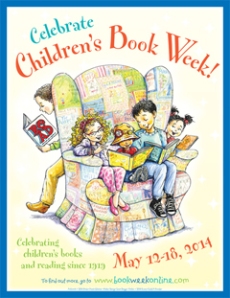
ENTER TO WIN a copy of Monster Needs His Sleep from Scarletta Kids!
- Leave a comment.
-
Enter the Rafflecopter (enters you for all 5 giveaways) Click a Rafflecopter giveaway (opens @ midnight)
-
Check out a blog or two from the CBW Giveaway Blog Hop, then return here and in this comment section, tell me what blog you left a comment and the blog number (A MUST for verification.)

Click HERE for blog list. Over 100 ways to win in this hop!
- Return tomorrow for more giveaways!
*** For complete rules, Click HERE.
Filed under: 5stars, Children's Books, Contests-Giveaways, Favorites, Library Donated Books, Picture Book, Poetry, Series Tagged: bedtime, children's book reviews, Children's Book Week celebrations, going to bed and stalling, monsters, Paul Czajak, Scarletta Kids, Scarletta Press, Wendy Grieb
Blog: Jen Robinson (Login to Add to MyJacketFlap)
JacketFlap tags: going potty, unconventional family structures, Reviews, bedtime, families, Newsletter, toddlers, Board Books, preschoolers, janee trasler, chicks, Add a tag
Books: Pottytime for Chickies and Bedtime for Chickies
Author: Janee Trasler
Pages: 24 each
Age Range: 2-4 (padded board books)
Pottytime for Chickies and Bedtime for Chickies, both by Janee Trasler, are part of a new series of padded board books focused on issues of interest to toddlers and early preschoolers (upcoming titles discuss the arrival of a new chick, and the development of table manners). Both books feature three little round chicks, apparently parented by three farm animals (Pig, Cow, and Sheep). The parent figures all look male to me, though this isn't completely, which makes for a nice, subtle message about varied types of families.
In Pottytime for Chickies, the chicks are, as you might suspect, learning how to use the toilet. They have their own ideas about what the potty is for, however, and when left to their own devices they do things like swim in the potty (ick!), and use the toilet paper like a trapeze. Each time, one of the parents returns, passes out hugs or kisses, and tries to get them onto the right track. So, for example, we have:
"Pottytime, Chickies.
Just two things.
First wipe your tail feathers,
then wash your wings.
Goodbye, Sheep.
Shut the door.
We know what the potty's for."
Followed by jumping off the back of the potty onto a pile of towels, followed by hugs and gentle redirection from Sheep. And in the space of a few short pages, the chicks figure out what to do. So, no, not the most realistic potty training book that parents can add to their arsenals. But it is pretty fun! My already potty-trained daughter pealed with laughter over the chicks in the potty.
Bedtime for Chickies tackles another common issue - the ways that kids will delay going to bed. Even as the adults are settling into their own beds, the chick are thirsty, have to go potty, and need a story, to the increasing chagrin of the three tired adults. Eventually, each chick ends up falling asleep in the lap of a similarly sleeping grown up animal (a more realistic ending than the first book).
One thing I liked about Bedtime for Chickies was the way the author teased kids, by making them think that a rhyme was coming when it wasn't. Like this:
It's bedtime for chickies.
It's bedtime for sheep.
It's bedtime for pig and cow.
Let's all go to ..."
My four-year-old immediately chimed in with "sleep." But in face, on the next page the text is:
"cheep, cheep, cheep.
We can't sleep.
We have to go potty."
The disruption in the text mirrors that disruption in the actual bedtime process. Nice.
Trasler's illustrations aren't realistic, of course, but the three round chicks are cute and kid-friendly, and the adult animals are quirky (and wear clothes). The adults come across as more nurturing in the potty book, vs. just exhausted in the bedtime book (both of which seem appropriate to me). The colors are soothing - not to bright, and the energy of the chicks is apparent on nearly every page.
I think this is a nice addition to the ranks of toddler-focused board books. These take a very light tone, and focus more on the universal humor of things kids do than on "teaching" a certain behavior. And I do love that the adult caregivers are apparently male and of different species than the kids. Not only does this make the book more visually interesting, it quietly tosses stereotypes aside (an usual thing in the board book world). Recommended new baby gifts or first through third birthdays. I look forward to seeing the other books in this fun new series.
Publisher: Harper (@HarperChildrens)
Publication Date: January 28, 2014
Source of Book: Review copies from the publisher
FTC Required Disclosure:
This site is an Amazon affiliate, and purchases made through Amazon links (including linked book covers) may result in my receiving a small commission (at no additional cost to you).
© 2014 by Jennifer Robinson of Jen Robinson's Book Page. All rights reserved. You can also follow me @JensBookPage or at my Growing Bookworms page on Facebook.
Blog: Kid Lit Reviews (Login to Add to MyJacketFlap)
JacketFlap tags: children's book reviews, toddler, Board Books, Debut Author, basic concepts, Sarah Jones, 4stars, Library Donated Books, Blue Manatee Press, counting 1 to 10, home learning, NonFiction, animals, colors, bedtime, baby, shapes, story time, Add a tag
Today we start with a question. Two questions, to be exact.
- Can you count to ten?
“1, 2, 3, 4, 5, 6, 7, 8, 9, 10”
Good!
2. Do you know your colors?
“Red, blue, yellow, green, orange— ”
—Okay, that’s great!
“. . . pink, purple, brown, black . . .”
Let’s get started. Debut Author Sarah Jones.
.
 .
.
by Sarah Jones
Blue Manatee Press 4/01/2014
978-1-936669-22-6
Age 1 to 4 10 pages
.
“Colors. Shapes. Critters! Three concepts in one make learning fun! Inspire bedtime or story time, with this fun and educational concept book! Watch colorful native forest animals including red square owl and yellow star frog take shape, teaching basic concepts simultaneously. Rich, sweet watercolor illustrations are a delight for sharing over and over again.”
Opening
“1 bunny near. 2 bunnies far.”
Review
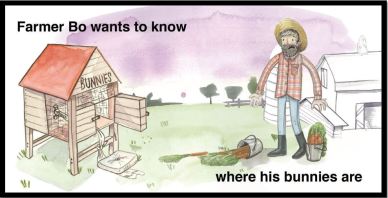
Farmer Bo has lost track of his bunnies. Where could they have gone? We know 1 bunny is nearby and 2 bunnies are far off. Where did 3 bunnies go, and 4 bunnies? I saw 5 bunnies going up and 6 bunnies going down—they were on a teeter-totter. Wherever 7 and 8 bunnies went in opposite directions. Then I heard 9 bunnies singing to 10 bunnies playing an instrument. Farmer Bo does not know where any of his bunnies are. Oh, look! Farmer Bo counts as the bunnies return home. 1-one, 2-two, 3-three . . . all the way to his 10-ten musical bunnies. Wow! How many bunnies is that?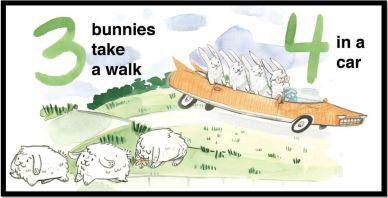
There are bunnies everywhere in Bunnies Near and Far. The situations the bunnies get into are common and recognizable by little kids. This is a fun way to learn how to count. The bunnies are cute though a tad plump and do some goofy stuff. Little kids will giggle at these bunnies on an apparent day off. I love the color of the book, which is predominately green with a few other colors tossed in on a few pages. The car is carrot orange and is somewhat shaped like a carrot. There even looks to be a smidge of green at the back of the car. I love details like this; things you would never expect. The theme of Bunnies Near and Far is more modern than most simple counting books and maybe that is what makes it so utterly charming.
.
Still remember your colors. (Please do not tell me, I remember.) Let’s look at colors.
.
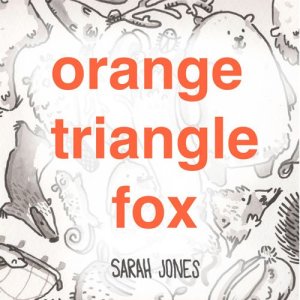 .
.
by Sarah Jones
Blue Manatee Press 4/01/2014
978-1-936669-21-9
Age 1 to 4 10 pages
.
“Farmer Bo wants to know where his bunnies are. Some are near, some are far, some walking some in a car, and all are as cute as can be! Little ones will learn counting and opposites in this fun tale of bunnies on the go. Perfect for sharing: read and count along to find out what they’ll do next!”
Opening
”brown circle hedgehog”
Review
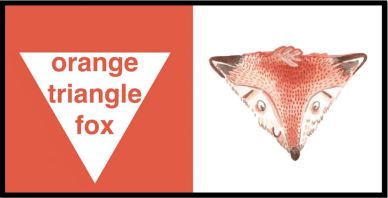
Orange, Triangle, Fox is about colors, shapes, and animals. What could be more perfect than all of these concepts in one book for the youngest children? Interestingly, the shape and color become the shape of the animal and its color. The title page is orange and the shape is a triangle. The fox is an orange triangle. I think this will delight kids. The forest animals include an owl, a fox, frog, and a turtle among others. Young children will simultaneously learn about three concepts—shapes, colors, and animals—learning to process multiple stimuli. They may start looking at the world around them for animals or other objects in a certain shape. The forest animals are adorable, maybe more so because of the shape they have become.
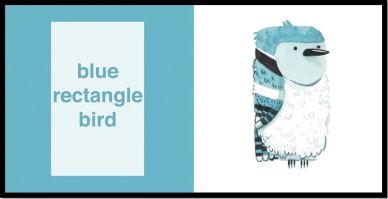
As a set, Orange, Triangle, Fox and Bunnies Near and Far help young children learn, or reinforce, their numbers, colors, and forest animals. The books are kid shaped, just the size for little hands to hold. The pages are thick to stand up to kids excitedly turning the page. Spilt milk and blobs of jelly should wipe right off the heavy, glossy pages. At ten pages, bedtime reading of Orange, Triangle, Fox and Bunnies Near and Far can start a tradition of reading and a lifelong love of books. Both of these books are nontraditional in form, but very much traditional in content. Little ones can learn about the numbers one through ten, and about colors, shapes, and animals. Four important elements your child needs to learn, packed into two adorable books with designs by Sarah Jones. Beautiful and functional, child-sized and childproof.
.
Learn more about Sarah Jones books for young children HERE.
Buy Bunnies Near and Far at Amazon
—B&N—your local bookstore.
Buy Orange, Triangle, Fox at Amazon
—B&N—your local bookstore.
.
Meet Sarah Jones at her profile at scbwi: http://www.scbwi.org/members-public/sarah-jones
Find more board books at the website of Blue Manatee Press: http://bluemanateepress.com/
.
ORANGE TRIANGLE FOX and BUNNIES NEAR AND FAR. Text and illustrations copyright © 2014 by Sarah Jones. Reproduced by permission of the publisher, Blue Manatee Press, Cincinnati, OH.
.
NEW FROM BLUE MANATEE PRESS.

Water, Baby Unplugged
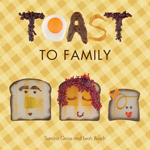
Toast to Family
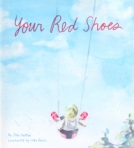
Your Red Shoes

Filed under: 4stars, Board Books, Debut Author, Library Donated Books, NonFiction Tagged: animals, baby, basic concepts, bedtime, Blue Manatee Press, children's book reviews, colors, counting 1 to 10, home learning, Sarah Jones, shapes, story time, toddler
Blog: The Children's Book Review (Login to Add to MyJacketFlap)
JacketFlap tags: Adventure, Siblings, Bedtime, Sleep, Author Showcase, Fears, The Sandman, Andrew McLeish, Add a tag
This charming story is perfectly suited for reading at bedtime—and best geared to readers aged 7 and older. Young readers will enjoy reading the story on their own but its comedic styling also makes it fun to read aloud. It is a dangerously exciting story but has a soothing end. The rhythm of the words and the playful tone of the story help to put bedtime fears to rest.
Add a CommentBlog: Picture Books & Pirouettes (Login to Add to MyJacketFlap)
JacketFlap tags: Animals, Blog Tour, Bedtime, Yoga, Yoga for Children, Giselle Shardlow, Good Night Animal World, Add a tag
The yoga-inspired text and the illustrations by Emily Gedzyk are all meant to help wind children down at night so they can relax and sleep well. What a great premise -- and one that definitely got me excited (especially as a mother) to look inside this book!
Below is the "turtle" page from the book, followed by a book trailer that includes other images from the book plus some book reviews -- all set to relaxing music, of course!
Blog: Alan Dapré - Children's Author (Login to Add to MyJacketFlap)
JacketFlap tags: cute, birthdays, bedtime, writing for children, panda, preschool, animal story, nursery tales, making friends, iBooks and eBooks - Self Publishing with Alan Dapré, alan dapre, Have Kid Will Scribble, picture ebook, cuddle, j r hartley, nursery story, simple plots, simple story, Add a tag
Do you remember that advert where an old man rings round bookshops until he smiles – puts on his hat – and nips out the door? He is looking for a book by J. R. Hartley and the twist is … Continue reading
Blog: Jen Robinson (Login to Add to MyJacketFlap)
JacketFlap tags: Reviews, Picture Books, parenting, Parents, bedtime, Newsletter, preschoolers, peachtree, sebastien braun, going to bed, night-time fears, Add a tag
Book: Back to Bed, Ed!
Author: Sebastien Braun
Pages: 32
Age Range: 2-5
I must confess that when I first received Back to Bed, Ed! by Sebastien Braun, I didn't fully appreciate it (and didn't review it). This was back in early 2010, when I was pregnant with my daughter (my first and only child). A picture book about a boy (well, a mouse) who keeps getting into his parents' bed, and the solution that his family finds for the problem, well, it seemed a bit ... slight to that pre-parent me. But NOW, 3 1/2 years later, I have come to consider Back to Bed, Ed! necessary and relevant. Now that I have a child who climbs into my bed multiple times a night, I can appreciate how spot-on Braun's work is. (Or at least I would be able to appreciate it if I wasn't so tired all the time.)
In fact, my plan for tonight is to copy Ed's parents' solution. Since this is a picture book, I'm not going to worry too much about spoilers, so I'll tell you. After many nights of being woken up (and kept awake) by Ed, his parents hang a "Closed" sign on the door. When he gets out of bed, he is stopped by the sign from entering their room. His dad walks him back to his room, where he gathers up all his stuffed animals into his bed and tells them "There's no need to be scared. I'm here now." (Image created by me, though similar to the one in the book.)
My daughter loves Back to Bed, Ed!, and she was actually the one to suggest the "Closed" sign (she's much braver by daylight than she is at night). We're going to bring all of her stuffed animals up from the playroom, and put them nearby, so that she can gather them into her bed, just like Ed does. I can only hope that life will imitate art.
For those of you facing a similar problem (or anticipating the possibility of facing a similar problem), Back to Bed, Ed! is an essential book for any preschooler's home library. The reactions of Ed's (tired) parents are spot-on. Braun's illustrations are a mix of realistic (groggy parents spilling cereal on the table) and fanciful (the monsters that Ed imagines following him into the bedroom).
Nothing in Back to Bed, Ed! is actually scary. The monsters look like friendly dinosaurs, and the night-time background colors are blues and purples, rather than the inky blacks of Lemony Snicket & Jon Klassen's The Dark. Jammie-clad Ed, clutching his stuffed bunny, is determined, then sad, and then, ultimately, pleased with himself.
I kept Back to Bed, Ed! around, even when I didn't really anticipate needing it, because I found Ed a likeable character. Now, he's practically a member of my family, and I highly recommend this book for anyone struggling to keep a preschooler in bed. It is still in print, with a paperback coming out in February, which suggests that I am not alone in my assessment.
Wish me luck!
Publisher: Peachtree Publishers (@PeachtreePub)
Publication Date: February 1, 2010
Source of Book: Review copy from the publisher
FTC Required Disclosure:
This site is an Amazon affiliate, and purchases made through Amazon links (including linked book covers) may result in my receiving a small commission (at no additional cost to you).
© 2013 by Jennifer Robinson of Jen Robinson's Book Page. All rights reserved. You can also follow me @JensBookPage or at my Growing Bookworms page on Facebook.
Blog: TWO WRITING TEACHERS (Login to Add to MyJacketFlap)
JacketFlap tags: bedtime, Read Aloud, illustrators, toddlers, mentoring, nighttime ritual, authors, Add a tag
It is important to say the name of the author and the illustrator when you read a picture book.![]()
Blog: Jrpoulter's Weblog (Login to Add to MyJacketFlap)
JacketFlap tags: early childhood, primary school, child psychology, early learning, Ripple Reader, quality time, Dr. Virginia Lowe, remedial teaching, children's books, reading, family, Uncategorized, literacy, picture books, children's literature, bedtime, Stories, illustrated books, grandparents, bonding, Add a tag
Reading – we all recognise it as a core skill. By ‘intelligent reading’, I mean reading with a level of comprehension commensurate with the child’s experience of the world they inhabit. Fortunately, reading to children is now encouraged as being supportive of reading literacy and as a sound foundation for future learning.
Not that long ago, children were seen as passive recipients of the eager parent’s input via the quality time spent in ‘read to me’ and ‘bedtime story’ sessions.
I always felt sure my children were taking in much more than the professional opinion allowed.
Recently, I borrowed a copy of Dr. Virginia Lowe’s very excellent book, “Stories, Pictures and Reality: Two children tell” (Routlege 2007) based on the record of her own two children’s responses to books from birth to adolescence. Dr. Lowe’s book vindicates what I felt all along as a parent! This book should be set reading for students of primary, early childhood and remedial teaching, child and family psychology and for anyone with an interest in literacy!
Her children had a smorgasbord of stories proffered continuously, both Dr Lowe and her husband being librarians who were passionate advocates of children’s literature. The children’s reactions to and responses concerning elements of story and illustrations provide a wonderfully insightful peek into the psyche of the child. Both Lowe children clearly had a blessed and privileged childhood, but being ‘read to’ is within the reach of most children. Public libraries and school libraries are accessible to most families. Even if parental work commitments make a nightly ‘reading’ impossible, there are weekends and visits to grandparents when a ‘storytelling’ session can be included in the agenda.
There are other options.
Storytelling sessions are held regularly in many public libraries and are ‘free’.
And online resources such as “Ripple Reader” and “A Story Before Bed” provide a way for even absent grandparents and parents to read to their children. In the USA and Israel, ‘bedtime stories’ are part of official early education policy. Programmes like “Reach Out and Read” and “Read to Me” do a monumental job in promoting literacy and the power of storytime to be a deeply meaningful and bonding time in families.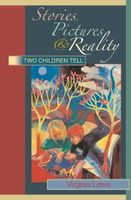
Blog: Kid Lit Reviews (Login to Add to MyJacketFlap)
JacketFlap tags: Children's Books, picture books, characters, jokes, costumes, bedtime, children's book, kitty, sleepy, silly, singing, senior citizens, dancing, dinner, grandma, pink, grandmothers, juggling, bedtime story, Flashlight Press, chef, sweet dreams, pink hair, baths, balancing, bubble bath, pickle, bath time, 5stars, diners, Library Donated Books, take a bow, chocolate milk, Anne Jewett, baby powder, bag of tricks, conga line, Darling Clementine, frilly, grand-daughters, grilled cheese and potato chips, hair dryer, Laurie A. Jacobs, pink shoes, roasted snake toes, Tillie Vanilly, towel dry, turban, worm chili, Add a tag
5 Stars Silly Frilly Grandma Tillie Laurie A, Jacobs Anne Jewett Flashlight Press 32 Pages Ages: 5 and up Inside Jacket: Sophie and Chloe are lucky that their Grandma Tillie knows how to be royally silly. To their delight, whenever Grandma Tillie babysits she seems to disappear, only to be replaced by a parade of [...]![]()
Blog: Library Goddesses Picture Books (Login to Add to MyJacketFlap)
JacketFlap tags: bedtime, sleep, toddlers, Add a tag
Goodnight Goodnight Sleepyhead is a very sweet book that is perfect for a bedtime read. Younger Toddlers will love the repetition of phrases as well as the fun of saying goodnight to body parts and parts of their room. The illustrations are adorable and soothing. Also Try: Goodnight Moon by Margaret Wise Brown The Going-To-Bed Book by Sandra Boynton On The Night You Were Born by Nancy Tillman
Blog: Read Now Sleep Later (Login to Add to MyJacketFlap)
JacketFlap tags: bedtime, Scholastic, 2012, creepy, spooky, Spooktacular, fishgirl182, Thuy, RebeccaElliott, ClemencyPearce, Halloween, book review, picture books, children's, Add a tag
Illustrated by Rebecca Elliott
Category: Children's Picture Book
Keywords: Children, picture book, bedtime, Halloween, spooky
Format: Hardcover
Source: Library
Frangoline is a girl who is good during the day but loves to sneak out of her bedroom at night to explore the world and the creatures in it. As Frangoline runs wild, the wise moon looks on, reminding her that children should be in bed at night, not out having adventures. But Frangoline does not heed the moon's advice, instead doing as she pleases.
Blog: wonkyworks (Login to Add to MyJacketFlap)
JacketFlap tags: children's kindle picture book, sleepy animals, bedtime, ebook, self published, Add a tag
I have just published a new kindle book, a companion volume to Happy Animals, Sleepy Animals is a bedtime book with simple rhyming text. As you say Goodnight to each animal and turn the page the animal goes to sleep and the stars come out in the sky. On some devices this can have the effect of a simple animation, which adds to the charm.
Here are some pictures of the Sleepy Animals!
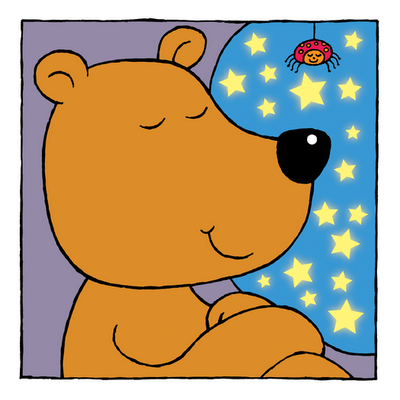
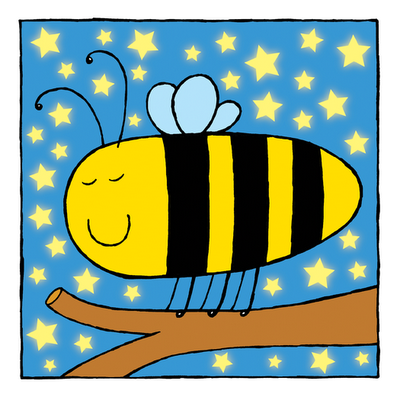
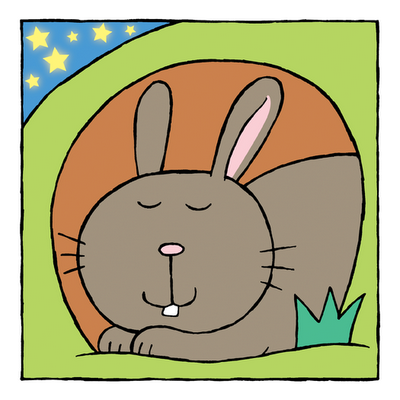
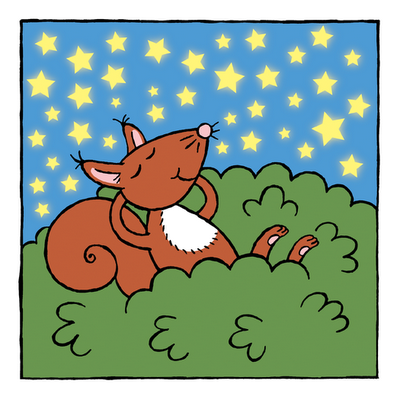
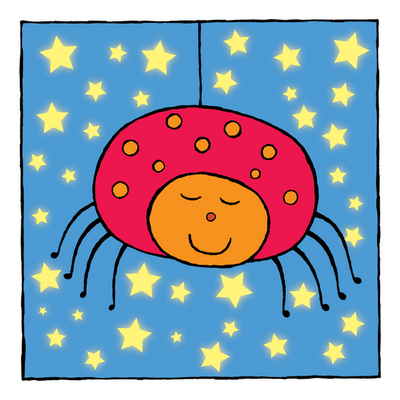
Blog: Read, Write, Repeat. (Login to Add to MyJacketFlap)
JacketFlap tags: Book reviews, Fiction, Picture Books, Bedtime, Abby, Rebecca Janni, Add a tag
 In many houses, going to bed is anything but a fun experience.
In many houses, going to bed is anything but a fun experience.
There are objections, arguments, tears and fears.
Jammy Dance (Farrar Straus Giroux, 2012) by Rebecca Janni and Tracy Dockray puts a happy spin on the bedtime ritual. The book features a brother and sister who, with a little help from Mom and Dad, dance their way into bed.
Today’s reviewer, Abby, has a brother, so she just might try her own jammy dance one night. (Although, as you’ll see below, the part of the book that really made an impression on her was the illustration of the dog drinking out of the toilet!)
Take it away, Abby!
—————–
Our reviewer: Abby
Age: 4.5
Things I like to do: Read books. Play with Mommy. Have play dates with Sienna.
This book was about: The jammy dance to help the brother and sister get ready for bed.
The best part was when: They jammy danced.
I smiled when: The dog was crushing the dolls.
I was surprised when: The dog was licking the potty water.
This book taught me: How to get ready for bed in a happy way.
Three words that best describe this book: “Dirty.” (The kids’ room was messy!) “Fun.” “Nice.”
My favorite line or phrase in this book is: “I love you.” (Editor’s note: This phrase isn’t actually in the book, but that’s what Abby remembers. And love is certainly an underlying theme of the book.)
My favorite picture in this book is: The dog drinking the potty water.
Other kids reading this book should watch for: The dog licking the potty water and the messy room.
You should read this book because: It’s fun!
—————–
Thank you, Abby!
If you’d like to learn more about author Rebecca Janni (who has had two other books reviewed on this blog by two different kids — Sonia and Brooke) you can visit her website.
If you’d like to learn more about illustrator Tracy Dockray, you can visit this site.
Add a CommentView Next 25 Posts




























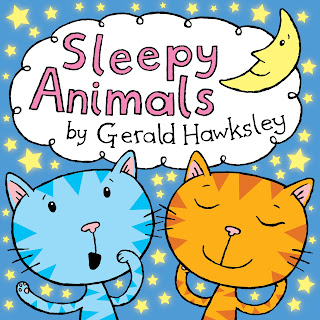
this does sound perfect for halloween! great review!